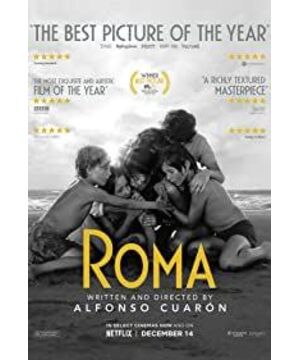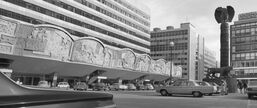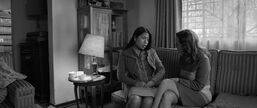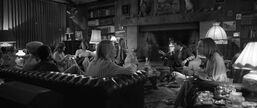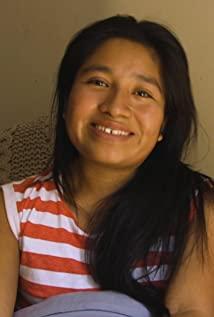1. About love
[Rome] is actually the reverse of [Love].
In Spanish, the reverse of [Rome] is precisely [Love], ROMA = AMOR;
Therefore, to a large extent this is a film about love.
This film is an autobiographical film by director Alfonso Cuarón. According to the director, 90% of the scenes in the film are derived from his own memories. In order to truly restore that memory, 70% of the furniture in the film was collected by Alfonso Cuarón himself during his travels throughout Mexico.
It can be said that [Rome] is the shelter of Alfonso Cuarón’s growth and his spiritual city . When he looks back in the past, the foundation on which this spiritual city relies is [love].
2. Abandonment and deception
The film narrates the story of two classes, two races, and two women being abandoned almost at the same time.
One is a maid, Cleo, of Indian descent, born to the toiling masses. Her lover Fermín (Fermín) is a social "idle person".
One is a female employer, Sofía (Sofía), white descent, born in the intellectual and elite class. Her husband Antonio (Antonio) is a famous doctor.
(1) Fermin's T-shirt
Cleo and Fermín;
The two had never seen each other since the first time, and Fermin always wore the same T-shirt .
The logo of the T-shirt is printed with a pair of cartoon lovers leaning against each other. A few words "Amor es..." means "What is love"?
Is love leaning against each other, talking badly, or seeing each other in battle? Fermin's sweet coat and inner determination, fierce appearance and cowardly heart, are really a great irony of love.
(2) Antonio's ring
Sofía and Antonio
Antonio went home early to finally choose to abandon his family, the most important sign is the ring on his finger.
In the previous scene with his family, Antonio wore a ring on his left hand ;
And when he left, one day the maid Clio cleaned up the house and found that the host had left the ring in the drawer .
He has decided to leave.
(3) Two parallel deceptions
Two periods of abandonment occurred almost one after the other.
Abandonment is often accompanied by deception and lies .
Antonio said to Sofia: Going to Canada for a business trip will only take a few weeks . However, he never returned, leaving Sophia and four lovely children behind.
Fermin said to Clio: Go to the bathroom and return soon . Then he went forever, and dropped the pregnant Clio.
3. Cars and Garages: Adaptation and Transformation
The [garage] and [car] in the film symbolize the adaptation and change of marriage .
[Garage] is the harbor of home. As long as the sound of the horn is heard, the family is full of joy and welcomes her husband Antonio home. [Garage] For a wandering soul, it is resting and resting, but for a family, it is expectation and acceptance.
However, the [dog shit] in [garage] is a mess in life, symbolizing all the trivialities and troubles in life.
(1) The changes of Antonio
Antonio drove home for the first time, and the huge body of the Gallesi car was out of step with the garage . In the lens, he constantly adjusted the angle of the body and the garage space, which symbolized his adjustment and adaptation to this marriage.
But the warmth at home failed to keep Antonio's heart; he complained, complained that the house was always messed up, complained that the house is always full of [shit]. This may be his view of the family and this marriage, so he changed to a smaller Beetle, left the garage, and left the marriage.
(2) Sophia's change
When Sophia had to face this dying marriage, she had to choose to be strong. Because this is always her home, she also has four lovely children, her mother, and Clio who is connected with the illness.
After returning from a drunk night, Sophia drove a huge Gallesi car. Facing the inadequacy of the body and the garage , she no longer adapts, reluctantly, and accommodates, but vigorously stepped on the accelerator, letting the car crash the garage column.
These show her inner struggles and struggles.
She walked out of the car door and grabbed Clio. The first sentence was: No matter what others say, we women are always alone. She knows: Women need to be independent and strong , and all this is because of a family.
She needs to seek a change in her life , so she changed to a small Lelo car, which symbolized the change in her view of life: to be independent, to be true to herself, and to take good care of her children.
Later, she sought a full-time job in a publishing house, not only because she needed to support her family, but also because she loved books to be herself .
The smashed garage column symbolizes the conflict and break in Sophia's heart.
The corner of the broken window is difficult to restore to its original state. Instead of adapting, it is better to change.
Sophia said to Clio even more to himself: the need to be independent, and to be strong.
Sophia changed a suitable car and tried to find a change in life.
Fourth, bid farewell to the past
In the film, there are two episodes that echo before and after, suggesting that the two heroines bid farewell to their past lives .
(1) Sofia’s farewell : her husband Antonio left slowly, leaving behind the huge Gallesi car , she left silent tears in the noisy marching band; the huge Gallesi car was left in her heart by her husband In the end, Sophia plans to sell the Galesi car, ending with a seaside trip, saying goodbye to her husband and her past life.
(2) Creo’s farewell : the lover Fermin fled away in a hurry, leaving behind a leather jacket, just like Fermin’s T-shirt, the clothes are Fermin’s image and imprint on her heart; later, Creo desperately wanted to find Fermin and returned to her leather jacket. More importantly, she still had something to say. After saying this, she bid farewell to her past self.
Husband Antonio left amidst the noise of a military band.
The Sofia family bid farewell to the trip, and when they returned, a noisy military band appeared again.
Ferming ran away in a hurry, leaving behind the leather jacket.
Creo wants to find Fermin and returns to his leather jacket to bid farewell to his past self.
Five, about the family
(1) Creo's family role
Cleo is the protagonist of the film, based on the director’s maid, Libo.
At the beginning of the film, Clio was the support of the family. In addition to washing, cooking, and sanitation every day, Creo sang songs to coax the children to sleep and get up early, and accompany them with their daily joys and worries. Creo wanted to be part of the family all the time. The family members watched TV together. She naturally sat down, and the children naturally hugged her. In the eyes of the children, she was already a member of the family .
The changes in Clio's relationship at home are more subtle. At first it was just a simple employment relationship. The hostess Sophia would stare at Creo at work, supervise them whether to turn off the lights, complain that she did not clean up the shit, and blame her for not preventing her children from overhearing the breakdown of the marriage. ...
However, it was the common situation , adversity and empathy that brought the relationship between Creo and Sophia closer.
Sophia began to listen to her troubles, talk to her, and take her to see a doctor... Later, Sophia invited her to travel by the sea and invited her to join a family meeting. Sophia accepted Creo as a family member . "If you have difficulties, we will spend it together, hand in hand, shoulder to shoulder, right? Creo."
When Clio desperately found the children in the storm, they hugged and wept.
Clio couldn't make a sound, and said the knot buried deep in her heart: She didn't want the child in her belly to survive at first.
She never told the secret to her close friends, nor did she tell her mother far away in the country.
After experiencing the edge of life and death, she told the Sofia family because she had already regarded them as her own family.
She is confessing to her family.
"We love you very much, Creo..."-what the family wants to tell Creo is: you are not nothing, please remember "you still have us, we hold hands, shoulder to shoulder, and go on an adventure together".
Saved and rescued: Creo saved the children, and the family comforted Creo with warmth. At this moment, she should be able to forgive herself.
Creo always lowered himself and felt the joys and sorrows of the children from his own perspective.
Creo naturally wanted to integrate into the family, but at this time she was not really accepted by the family adults.
"Angel" Pepe's love for Clio.
Sophia invites Creo to join the family trip.
Creo attended the family meeting. At this moment, she was accepted by the extended family.
Life needs to change, but we will spend it together.
The change of life, although there will be rough seas, it will still be a wonderful adventure.
Life needs to change, but we will spend it together. After the family meeting, the whole family thoughtfully ate ice cream; looking at the wedding in the distance from time to time, it brought out the sadness of everyone and heralded new hope.
Creo desperately seeks to find the child in the storm. At this moment, she seems to find her lost child.
The three of them hugged and wept.
The family hugs each other and warms each other.
(2) About family growth
After experiencing hardships, every member of the family has learned to grow .
On the way home, everyone thought about the changing scenery outside the car window.
(3) About family education
Facing the abandonment of her husband Antonio, Sophia's way of educating the children is remarkable.
She still conveys love to the children , not hatred .
The city of Rome where the children grow up has been surrounded by great maternal love and is indestructible.
Sophia asks the children to write to their father and ask him to come back. In fact, she already knew the fact that Antonio had derailed.
Sophia told the children the truth about the breakdown of their marriage, but still said that his father loves you.
In family education, the most important thing is to convey love, not hatred.
V. About the social and historical background
Director Alfonso Cuarón publicly stated: "This film describes the history of his life, the profound society and time, like scars left behind, which make each of our individual lives change. Time Harmony space contains our individual, which not only defines us, but also connects us with others in the same time and space. This is an exploration of the Mexican social class , in which hierarchy and race are intertwined; but first of all, this is a picture of nurturing The portraits of me and the women who have a close relationship with me , it is about the recognition of love , and it travels through time, space and memories."
Alfonso Cuarón's statement for the film: "There are periods in history that scar societies and moments in life that transform us as individuals. Time and space constrain us, but they also define who we are, creating inexplicable bonds with others that flow with us at the same time and through the same places. Roma is an attempt to capture the memory of events that I experienced almost fifty years ago. It is an exploration of Mexico's social hierarchy, where class and ethnicity have been perversely interwoven to this date and, above all, it's an intimate portrait of the women who raised me in a recognition of love as a mystery that transcends space, memory and time."
Regarding the social and historical background of the film, there are several clues in the film:
(1) Tlatelolco incident
The film is also known as "México '68" ( Mexico 68), which is Mexico in 1968. In October of this year, Mexico bid for the 19th Olympic Games, and just a few days before the Olympic Games , a brutal suppression of student sports took place in Mexico , known as the " Tlatelolco Incident ." According to the follow-up investigation of the incident, the incident was provoked by the Olympia Battalion, a group preparing for Olympic security. It was ordered to arrest the leader of the student movement and caused conflicts. The conflict resulted in the death of hundreds of students.
In the film, Fermin joined the organization to train sticks in an organized manner to serve the suppression of clearing the field. It also explained the subsequent riots that cleared the field with a stick in hand, and that Fermin and his group shot and killed a student in a furniture store.
(2) Participation of external forces
Regarding the Mexican crackdown in 1968, historical data has evidence analysis showing that the CIA was involved in it.
There are several details about this in the film. The coach of Fermin who participated in the training field, according to Fermin, a coach from the United States and later from South Korea , hinted that the United States and its allies were training them secretly.
Also, pay attention to letters and icons on the coach jacket, the letters " WES PONT " and "WEST POINT" ( America West Point ) shy of a few letters, and Logo on the clothes is the badge of the US West Point .
(3) The latter
The latter part of the incident was the then Minister of the Interior of Mexico and later the former President of Mexico Luis Echeverría (Luis Echeverría). Wikipedia shows that Echeverria was charged in 2006 with the massacres in 1968 and 1971.
In 2006, he was indicted and ordered under house arrest for his role in the 1968 Tlatelolco massacre and the 1971 Corpus Christi massacre
In this point, in the film, election posters are posted everywhere on the streets, it is Luis Echeverría (Luis Echeverría).
(4) Class-race antagonism
The deeper background of the repression is Mexico’s intricate class and racial opposition.
The film reflects the conflict between the elite class represented by whites and the peasant class represented by indigenous Indians in Mexico at that time .
Elite classes available through government and military land, farms and other industries, are free to travel by car, hunting; and the American Indian is land seizures , become the employer, in material life have to rely on the elite class.
Take Christmas in the film as an example. The owner and relatives and friends sing and dance in a large, bright and warm room.
The Indian servants can only squeeze in the dark and narrow basement and whisper their New Year wishes.
More ironically , when forest fires occur, we run ahead of the local indigenous Indian descent.
And the white employers were behind the crowd, drinking and talking.
The fire on Christmas Eve indicates that a revolution is about to break out .
The dog killed by the manor’s house was a revenge for a land fight.
The land of Clio's family, without exception, was forcibly confiscated by the government and interest groups.
White people’s Christmas: bright and warm.
Christmas for Native Mexicans: murky and small.
The indigenous Mexicans rushed to fight the fire, and the white people greeted each other with their drinks.
The forest fire on Christmas Eve implies that a revolution is about to come.
Six, stillbirth and revolution
Creo's stillbirth is actually a metaphor for the abortion of the revolution .
Creo's pregnancy represented the birth of a native Mexican revolution.
And this revolution was destined to face the suppression, disintegration and strangulation of the white elite from the very beginning .
From Creo’s perspective, there are many hints in the film:
1. In the hospital in the earthquake, the peeling building stones hit the baby box ;
2. The cross in the camera after the earthquake heralds death and end ;
3. Celebration in the basement on Christmas Eve, Creo's accidentally broken cup (in Maya civilization, the cup symbolizes the womb);
4. The scorched earth after the fire and the capture of survivors (lizards) ;
5. Creo is Valentine's take a gun pointed at, water broke up;
6. Clio was helped to leave the furniture store. In the camera, the female student held the slain classmate in her arms and wept bitterly ;
7. Creo delivered the baby in the hospital, holding his stillborn daughter in his arms (echoing with the sixth shot).
The impact of the revolutionary abortion on contemporary Mexico is far-reaching.
If someone wants to find a similar expression of indifference to contemporary Mexican politics, the retrospective path will undoubtedly lead us back to October 1968, when most people in Mexico were no longer naive to politics.
For them, the most important significance of Tlatelolco is that it is recognized that after October 2, 1968, everything in Mexico changed. Mexico’s economy did seem to continue its boom after World War II, even with an annual growth rate of close to 6% for most of the 1970s. The result is—perhaps not all—many Mexicans have hopes that their children will have more prosperous material conditions than themselves. However, after 1968, the legitimacy of the regime, the government, and the Revolutionary Institutional Party, as well as people's confidence in the promise of the Mexican Revolution, were completely shattered.
Not surprisingly, the usual atrocities committed by the federal government and local armed forces against the Mexican poor, especially the indigenous poor, have received little attention compared to the massacres involving middle-class students.
——Excerpt from " The Romance of Democracy: The Silent Protest of Contemporary Mexicans "
At this point, I can’t help but think of a set of beautiful shots at the beginning of the film. Creo washes his clothes and mutters ballads:
...When I tell you my poverty
You never smile again
I long to have everything
Put them one by one at your feet
But i was born poor
You will never love me...
And the dialogue between Clio and Pepe:
I can't talk, i'm dead
Well, I kind of like the feeling of being dead
What the director wants to express is " silent resistance ":
A city of freedom and democracy is not so easy to build, but there is still hope.
Because [Rome] was not built in a day.
Rome was not built in a day
Seven, inner peace
"Shantih Shantih Shantih." appeared in the ending subtitles
Shantih comes from Sanskrit, which means peace of mind .
Generally, it appears three times at the end of the scripture, which means the elimination of the three levels of suffering (the suffering of the body, the suffering of the natural force, and the suffering of the soul) .
This should represent the director's wish for a better life.
Interestingly, in the training ground in the film, it seems that only Clio achieves a state of peace of mind.
8. Some interesting details
Finally, let’s talk about some relaxing topics, some interesting details in the film.
(1) Imagery of airplane
The image of [aircraft] appears repeatedly in the film: the aircraft reflected by the floor foam, the aircraft over the training ground, and the aircraft over the yard at the end of the film.
One is symbolizing the concept of vast space and fleeting time.
Second, it symbolizes the economic background of Mexico's rapid take-off (the Olympic Games were held in 1968, and the World Cup was held in 70 years).
(2) The image of the astronaut
The image of [ astronaut ] that appears in the film symbolizes the director's dream.
Being an astronaut has always been the childhood dream of director Alfonso Cuarón . His representative work " Gravity " (Gravity) is one of my favorite films, which fulfilled his childhood dream.
The pictorial on the wall of the boys’ bedroom has themes such as moon landing and astronauts.
Another: MEXCO 70 on the door is the 1970 World Cup in Mexico, so the memory scene of the film is selected from the time period of 1968 to 1970.
On a Christmas picnic, men play with guns, while the boy in the shot is wearing a spacesuit, imitating traveling in space.
In the suburbs, a boy made a self-made aerospace helmet with a bucket, imitating a trip to the moon.
The movies that the boys went to the cinema to watch were about astronauts, but they also paid tribute to their own "Gravity" movie.
Scenes from "Gravity"
To pay tribute to "Escape from the Tiger's Mouth" in 1966, the movie may also be one of the director's childhood dreams.
(3) Who will be the director?
Who of the three boys will be the director in the film?
Looking along the image of [astronaut], it is not difficult to find:
1. In the film 00:29:27, the astronaut pictorial on the wall of the boys' bedroom is on the bedside of Paco;
2. At 00:55:34 in the film, the astronauts on the wild hunting grounds are dressed up as Pepe;
3. Movie 01:14:17, go to the cinema to watch a movie about astronauts, it’s Toño;
Therefore, the director should be a group portrait of three boys , not a specific one.
(4) The specific time of occurrence in the film
In what year did it happen in the film?
as described above:
1. 1968: The clue is the film "México '68" and the dialogue between Creo and Fermin at the training ground;
2. 1970: The clue is 00:29:27 the pictorial on the wall of the boys’ bedroom, México70, football icon and mascot (1970 World Cup in Mexico);
3. 1971: The clue is 00:54:39 Clio looked at the dog head specimen on the wall, and learned from the conversation that the dog "Cinnamon died last year", and the nameplate below was in 1970, so it was in 1971; Another clue is that the Christmas Eve vinyl record should be released around 1971. This record will be detailed below.
Therefore, the film has no specific time. It is the director 's combination of memories from 1968 to 1971 .
(5) The most beautiful music in the film
I personally feel that the most beautiful background music in the whole film is the vinyl record "I Don't Know How To Love Him" played on Christmas Eve , taken from the musical "I Don't Know How To Love Him" created by Andrew Lloyd Webber in 1970 "Jesus Christ Superstar" ("Jesus Christ Superstar"), sung by Yvonne Elliman.
Click here ☞ "I Don't Know How To Love Him" expresses Mary Magdalene's unrequited love for Jesus in the musical, which fits Creo's mood at the time.
Found the version closest to the record, which is consistent with the record icon.
"Rome", a good combination of thinking about idealism and realism, is worth recommending.
over.
View more about Roma reviews


